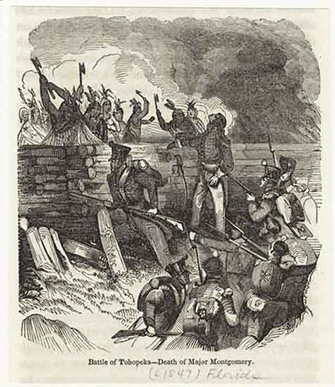Although the Cherokee had supported the British during the American Revolution, elder tribal leaders elected to join a confederacy of other Southeastern Tribes that provided support for the United States’ suppression of the Red Sticks.
The fear of encroaching violence coupled with a desire to separate themselves from the actions of the Red Sticks led Cherokee leaders to accept the request for military assistance against the Upper Creek issued by the United States.

Art and Picture Collection, New York Public Library
The Red Sticks, who derived their name from their red ceremonial war clubs, were a nativist or conservative faction of Creeks, predominantly from the Upper Towns, that rejected the relationship (with its subsequent selective cultural exchange) that the Lower Towns were fostering with the nascent United States. In August of 1813, following a series of skirmishes with the Mississippi Territorial militia, the Red Sticks overwhelmed Fort Mims (located in present-day Southwest Alabama) using weaponry provided to them by the British and Spanish. Upon defeating the militia garrisoned on the fortified plantation, the Red Sticks killed nearly every Lower Creek and white settler who had sought refuge there. The dramatic victory by the Red Sticks at Fort Mims sent reverberation across the United States that, ultimately, thrust the nation into the Creek Civil War.
The Cherokee, whose traditional lands bordered the Creek’s, were acutely aware that the conflict between the two Creek factions could spill into their own towns. The fear of encroaching violence coupled with a desire to separate themselves, in the eyes of the United States and its citizenry, from the actions of the Red Sticks led Cherokee leaders to accept the request for military assistance against the Upper Creeks issued by the United States.
In October of 1813, Cherokee men arrived for service under General Andrew Jackson (later referred to as “Sharp Knife” by American Indians). As the commander of the United States forces, Jackson initially used the Cherokee primarily as interpreters, guides, or scouts but faced with the onset of winter and the serial desertion of his white troops began to rely more heavily on his native allies for security.
The coalition of Indian and United States troops continued their advance through Red Stick Territory and in March of 1814 engaged in the most significant conflict of the Creek War: the Battle of Horseshoe Bend. The battle took place at the the Red Stick stronghold known as Tohopeka (located in present day Eastern Alabama). The site was a heavily fortified peninsula on the Tallapoosa River where the Red Sticks had cleverly created an elaborate barricade that prevented a frontal assault. The rear was protected by a river that was seasonally high and turbulent.
Led by Tuq-qua (“The Whale”) a group of three Cherokees swam across the Tallapoosa River, pilfered some of the Red Sticks beached canoes, and began ferrying their comrades across in order to strike at the rear of the Red Stick forces. The unexpected assault by the Cherokee caused some on the front line of the Red Sticks, entrenched behind their fortifications, to leave their position to engage the nearly 200 Cherokee warriors that had crossed the river. The opening allowed for the, eventual, successful frontal assault on Tohopeka. The Battle of Horseshoe bend proved to be the decisive struggle in the Creek War as the strength of Red Stick force was broken at Tohopeka.
Last updated: August 14, 2017
